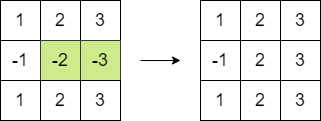1975. Maximum Matrix Sum


Description
You are given an n x n integer matrix. You can do the following operation any number of times:
- Choose any two adjacent elements of
matrixand multiply each of them by-1.
Two elements are considered adjacent if and only if they share a border.
Your goal is to maximize the summation of the matrix's elements. Return the maximum sum of the matrix's elements using the operation mentioned above.
Example 1:

Input: matrix = [[1,-1],[-1,1]] Output: 4 Explanation: We can follow the following steps to reach sum equals 4: - Multiply the 2 elements in the first row by -1. - Multiply the 2 elements in the first column by -1.
Example 2:

Input: matrix = [[1,2,3],[-1,-2,-3],[1,2,3]] Output: 16 Explanation: We can follow the following step to reach sum equals 16: - Multiply the 2 last elements in the second row by -1.
Constraints:
n == matrix.length == matrix[i].length2 <= n <= 250-105 <= matrix[i][j] <= 105
Solution
maximum-matrix-sum.py
class Solution:
def maxMatrixSum(self, matrix: List[List[int]]) -> int:
rows, cols = len(matrix), len(matrix[0])
total = count = 0
mmin = float('inf')
for i in range(rows):
for j in range(cols):
total += abs(matrix[i][j])
if matrix[i][j] < 0: count += 1
mmin = min(mmin, abs(matrix[i][j]))
if count % 2 == 0:
return total
else:
return total - 2 * mmin